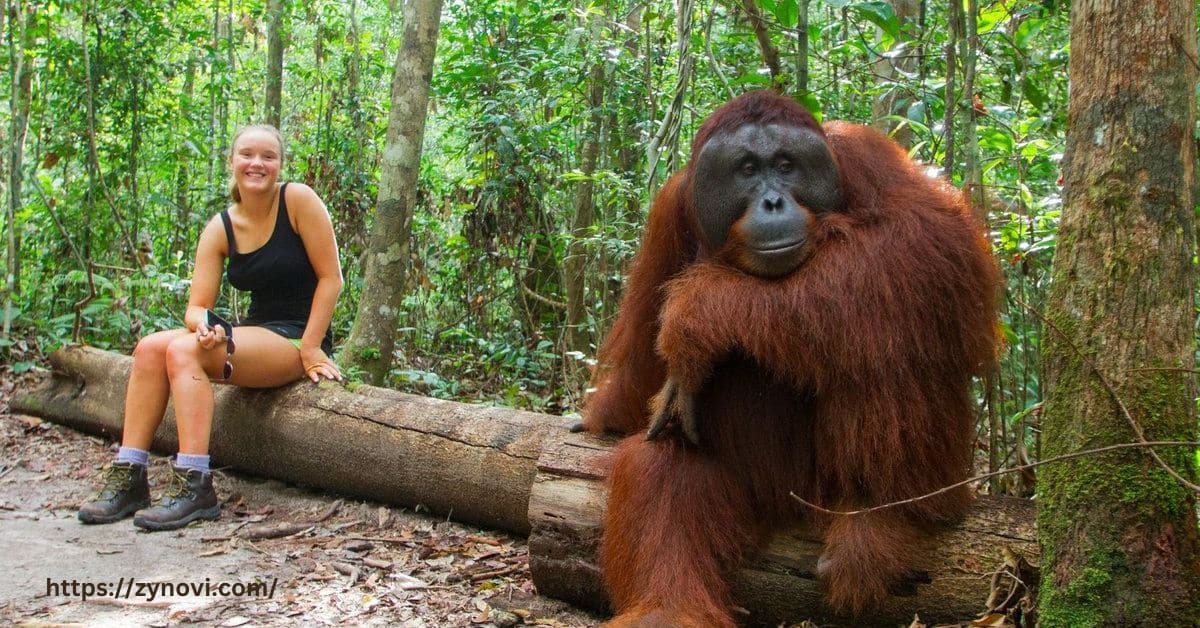Do orangutans attack humans? They are generally peaceful creatures, with aggression typically occurring only in self-defense or under stress.
This question has likely crossed your mind, especially if you’ve ever seen one of these fascinating creatures in the wild.
While orangutans are known for their intelligence and peaceful nature, there are misconceptions that need to be addressed. This blog find the myths and realities of human-orangutan interaction, shedding light on orangutan social behavior, conservation efforts, and safety guidelines for encounters with these majestic creatures.
Do Orangutans Attack Humans? Understanding Orangutans
What are Orangutans?
Orangutans are remarkable members of the great ape family, known for their intelligence, unique behaviors, and critical role in the ecosystems they inhabit.
Native to the dense tropical rainforests of Borneo, Sumatra, and Tapanuli, these fascinating primates are among humanity’s closest relatives, sharing an astounding 97% of their DNA with humans.
This genetic similarity not only highlights their advanced cognitive abilities but also underscores their importance in understanding our evolutionary history.
The name “orangutan” is derived from the Malay words “orang,” meaning “person,” and “hutan,” meaning “forest,” which fittingly translates to “person of the forest.”
These magnificent creatures are icons of their rainforest homes, symbolizing the incredible biodiversity of these endangered ecosystems. However, their existence is increasingly threatened by habitat destruction, making their protection more vital than ever.
| Key Facts About Orangutans | Details |
|---|---|
| Physical Characteristics | Adult orangutans boast an impressive arm span of up to 7 feet, ideal for life in the trees. Males can weigh up to 200 pounds, with robust bodies adapted for climbing and swinging. |
| Diet | Primarily frugivorous, they thrive on a diet of fruits, complemented by leaves, bark, and insects. This diverse diet highlights their adaptability to seasonal food availability. |
| Habitat | Found in the dense, tropical rainforests of Southeast Asia, orangutans are highly arboreal, spending most of their lives navigating the treetops with agility and strength. |
Behavioral Characteristics
Orangutans are predominantly solitary creatures, unlike the more social chimpanzees. Males typically live alone, while females nurture their young for up to eight years, displaying profound maternal instincts.
Unique behaviors include:
- Tool Use: Orangutans are skilled at crafting and using tools, such as shaping sticks to extract insects from crevices or to access seeds and fruit pulp. This ability demonstrates their ingenuity and adaptability in the wild.
- Cognitive Function: Their problem-solving skills rank among the most advanced in the animal kingdom, rivaling those of chimpanzees. Orangutans have been observed planning actions, remembering solutions, and even teaching these techniques to their offspring.
- Communication: Orangutans rely on a complex system of vocalizations, facial expressions, and gestures to interact with others. From long calls by males to assert territory to playful gestures among juveniles, their communication reflects their intelligence and social complexity.
Natural Temperament
Orangutans are known for their inherently peaceful nature, setting them apart from other great apes like chimpanzees, which are often more aggressive.
They are generally non-territorial and avoid conflict whenever possible, preferring a solitary and tranquil lifestyle in the forest canopy.
This calm demeanor, combined with their deliberate and thoughtful movements, has earned them the reputation of being gentle giants and one of the most serene inhabitants of the rainforest.
Do Orangutans Attack Humans? Instances of Orangutan Aggression

Orangutan kills human? Here are some aggression behavior about that
Orangutan Kills Human? Myth vs. Reality
- Exaggerated Threat: The notion that orangutans frequently attack humans is mostly a myth, perpetuated by sensationalized stories. In reality, orangutans are naturally shy and avoid human contact unless provoked.
- Rare Aggression: Documented cases of orangutan aggression are exceptionally rare. Such incidents often stem from fear or stress, usually due to habitat encroachment or feeling cornered.
- Misunderstood Behavior: Behaviors like vocalizations or arm-raising, often seen as signs of aggression, are typically defensive rather than offensive, aimed at deterring perceived threats rather than initiating conflict.
What Triggers Aggressive Behavior?
What causes the orangutan to become violent? While aggression is uncommon, certain triggers can provoke defensive actions:
- Encroachment on territory: Orangutans may react defensively if humans intrude on their space.
- Protecting offspring: Like many animals, orangutans can become aggressive when their young are threatened.
- Stress-related behaviors: Habitat loss or captivity-induced stress can lead to unusual behavior.
Recorded Cases of Human-Orangutan Conflicts
How many humans have been killed by orangutans? Recorded cases of human-orangutan conflicts are extremely rare and typically occur when orangutans feel threatened, cornered, or stressed.
In captivity, the stress of confinement and lack of natural stimuli can sometimes lead to aggressive behavior. However, in the wild, such conflicts are virtually nonexistent as long as humans respect the orangutans’ habitats, avoid intrusion, and maintain a safe distance from these peaceful creatures.
Human-Orangutan Interactions

Types of Interactions
Humans and orangutans interact in several ways, including:
- Eco-Tourism: Many people visit orangutan-rich regions to observe these magnificent creatures in their natural habitats. Ethical eco-tourism fosters appreciation and generates funds for conservation, but it requires strict guidelines to minimize disturbance to the animals.
- Wildlife Sanctuaries: Facilities like the Borneo Orangutan Survival Foundation rescue, rehabilitate, and release orangutans back into the wild. These sanctuaries also play a vital role in educating the public and advocating for conservation.
- Encounters During Deforestation: As deforestation destroys their habitats, orangutans are forced into human-populated areas in search of food or shelter. These encounters increase risks for both orangutans and humans, highlighting the urgent need for habitat protection.
Dos and Don’ts in the Wild
Can orangutans kill you? When encountering wild orangutans, follow these guidelines to ensure safety for both parties:
- Maintain a Safe Distance: Always keep a minimum distance of 10 meters from wild orangutans. This helps reduce the risk of disturbing them and allows you to observe them without causing stress or provoking any defensive behavior.
- Avoid Provocation: Never attempt to feed or touch wild orangutans. This can lead to unwanted interactions, stress the animals, and alter their natural behaviors. Respect their space and allow them to remain undisturbed.
- Observe Signs of Aggression: Pay attention to warning signals such as raised arms, vocalizations, or bared teeth. These behaviors indicate that the orangutan feels threatened or cornered, and it’s best to calmly retreat and avoid further contact.
Safety Tips for Humans
Do Orangutans Attack Humans? Here are some safety tips you can follow these if something happens like that
- Stay Calm: If an orangutan approaches, stay calm and avoid sudden movements to prevent escalating tension. This helps both you and the orangutan remain at ease.
- Respect Their Habitat: Avoid loud noises or any disruptive actions that may disturb the orangutan’s natural environment. This ensures their peace and safety.
- Carry a Whistle or Signal Device: Carry a whistle or signal device to alert orangutans of your presence and ensure your safety while trekking in their territory.
The Role of Conservation Efforts

Addressing Human-Wildlife Conflict
Human-wildlife conflict arises as a result of deforestation, largely driven by the demand for palm oil plantations, which contribute significantly to habitat loss for orangutans. As their natural environments are destroyed, orangutans are forced into closer contact with humans, often leading to encounters that can turn dangerous.
To mitigate these conflicts, organizations like the Sumatran Orangutan Conservation Programme work to establish wildlife corridors.
These corridors enable orangutans to travel safely between fragmented forests, reducing human-orangutan interactions and promoting the restoration of habitats. Through these efforts, the aim is to secure a future for orangutans while maintaining ecological balance.
Protecting Orangutan Habitats
Protecting the rainforests of Borneo and Sumatra is essential for orangutan survival. Initiatives include:
- Reforestation programs to restore degraded land.
- Establishing protected areas to safeguard their natural environment.
| Organization | Conservation Initiative |
|---|---|
| Orangutan Foundation International | Rescues and rehabilitates orangutans. |
| Borneo Orangutan Survival Foundation | Focuses on reintroduction and habitat protection. |
| Sumatran Orangutan Conservation Programme | Works to mitigate human-orangutan conflicts. |
Supporting Conservation Work
You can support efforts through:
- Donations: Many conservation organizations depend on public support to fund their efforts. Your donations can directly contribute to habitat protection, rehabilitation programs, and anti-poaching initiatives.
- Volunteering: Get involved by volunteering at rehabilitation centers or supporting awareness campaigns. Hands-on participation can help orphaned orangutans and educate others about the importance of conservation.
- Advocacy Efforts: Promoting sustainable practices, such as choosing palm oil alternatives, helps reduce habitat destruction. Advocacy can create a broader shift towards eco-friendly consumption, aiding orangutan protection.
Importance of Eco-Tourism
Eco-tourism plays a crucial role in both funding and educating the public about orangutan conservation. By visiting responsible eco-tourism sites, travelers contribute financially to the protection of orangutans and their habitats.
This type of tourism promotes awareness about the challenges orangutans face, such as habitat destruction and poaching. Tourists learn about the importance of preserving rainforests and supporting sustainable practices.
Additionally, eco-tourism helps foster a deeper connection between humans and wildlife, encouraging more people to advocate for the conservation of these incredible creatures and their ecosystems.
Final Verdict
In conclusion, orangutan attacks on humans are exceptionally rare and typically result from misunderstandings or threats to their safety. These peaceful creatures, known for their gentle nature, rarely show aggression unless provoked or cornered.
By recognizing and respecting their territorial boundaries, habitat needs, and natural behaviors, humans can help ensure peaceful coexistence. Educating the public about conservation and implementing sustainable practices will reduce human-orangutan conflicts, allowing these magnificent creatures to thrive in their natural environments without the risk of conflict.
FAQs
Are orangutans aggressive to humans?
Orangutans are rarely aggressive, with attacks being exceptionally rare and usually provoked.
Is orangutan friendly to humans?
Orangutans are generally peaceful and non-aggressive unless threatened or cornered.
Has an orangutan ever hurt a human?
While rare, some orangutans have hurt humans, typically due to provocation or stress.
Can a human fight an orangutan?
Humans should never attempt to fight an orangutan, as they are much stronger and more powerful.
What should I do if I encounter an orangutan in the wild?
Remain calm, maintain distance, and avoid sudden movements or loud noises.
Conclusion: Do Orangutans Attack Humans?
In conclusion, orangutans are essential to the health of our planet’s ecosystems. As great apes with remarkable intelligence, they play a vital role in maintaining the balance of the rainforest by dispersing seeds and fostering biodiversity.
By supporting conservation initiatives, promoting sustainable land-use practices, and reducing deforestation, we ensure the survival of orangutans and contribute to a healthier planet for future generations.
“Protecting orangutans isn’t just about saving a species; it’s about preserving the lungs of our planet the rainforests.”










